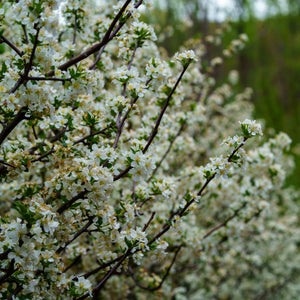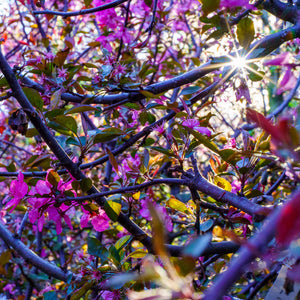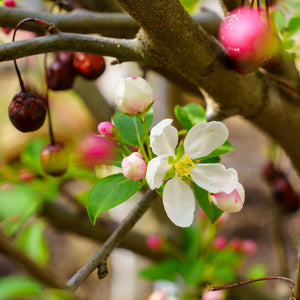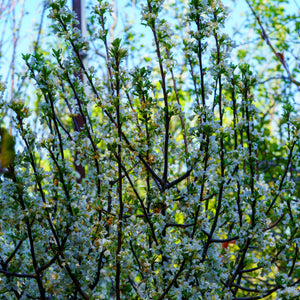The Crabapple Guide
Crabapple trees (Malus spp.) are a beloved staple in American landscapes, admired for their ornamental blooms, colorful fruit, and compact size. These small, deciduous trees offer year-round appeal—delivering vibrant spring blossoms, lush summer foliage, vivid fall fruit, and interesting winter structure. With dozens of cultivars available in a range of shapes, colors, and disease resistance levels, crabapples are highly adaptable and serve as exceptional focal points or support players in mixed garden designs.
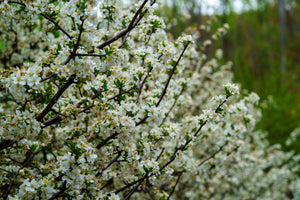
About
Crabapples are members of the rose family (Rosaceae) and closely related to orchard apples (Malus domestica), but their fruits are smaller—typically less than 2 inches in diameter. Native to temperate regions around the globe, most modern ornamental crabapples are hybrids selected for improved bloom, form, and disease resistance.
Some standout cultivars include Malus 'Adirondack', a narrow, upright tree that fits beautifully into small gardens; Malus 'Royal Gem', with deep red leaves and purple flowers; and Malus 'Sugar Tyme', known for its long-lasting white blossoms and resistance to rust, mildew, and fire blight. Malus 'Prairie Fire' provides a bold statement with magenta blooms and reddish foliage, while Malus 'Golden Raindrops' offers a more delicate look with fine-textured leaves and yellow fruit.
Crabapples attract bees and other pollinators in spring and provide a food source for birds through fall and winter. Their ability to handle urban conditions, from compacted soil to air pollution, makes them a popular choice for street-side plantings, residential landscapes, and public spaces.
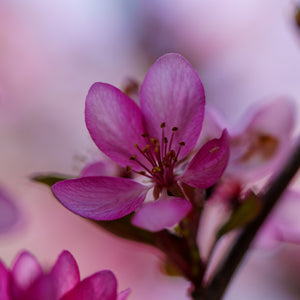
PLANTING
When planting crabapples, selecting the right site and variety is key to success. Their manageable size and wide adaptability make them easy to incorporate into most landscape plans.
USDA Hardiness Zones: Most crabapple varieties are hardy in Zones 4–8, though specific cultivars like Malus 'Adirondack' or Malus 'Donald Wyman' may vary slightly.
Soil: Well-drained loam is ideal, but crabapples can tolerate clay and sandy soils as long as drainage is adequate.
Sunlight: Full sun (at least 6 hours per day) is essential for optimal flowering, fruit production, and disease resistance.
Watering: Water newly planted trees regularly for the first year. Mature trees are moderately drought-tolerant but benefit from supplemental watering in extended dry periods.
Spacing: Depending on the cultivar, spacing should range from 10 to 25 feet apart. Malus 'Lollipop' stays compact, while Malus 'Prairie Fire' and Malus 'Snowdrift' may require more room.
Planting Time: Spring and fall are the best seasons for planting. Avoid planting during periods of extreme heat or frost.
Crabapples are grafted trees, so ensure the graft union is above soil level when planting. Mulch around the base to retain moisture, but keep mulch away from the trunk.
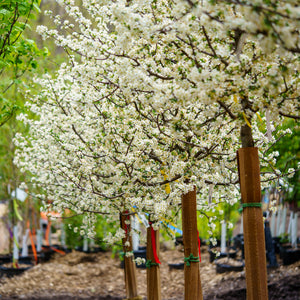
CARE
Crabapple trees are low-maintenance once established but do benefit from annual attention to pruning and disease prevention.
- Watering: Keep soil evenly moist during the establishment period, then reduce watering as the tree matures.
- Fertilizing: Feed in early spring with a balanced, slow-release fertilizer if growth seems weak or flowering is sparse.
- Pruning: Prune in late winter or early spring before buds break. Remove dead, damaged, or crossing branches. Open the canopy to improve air circulation.
- Disease Resistance: Choose cultivars like Malus 'Sugar Tyme' or Malus 'Red Jewel' to avoid common diseases like apple scab, cedar-apple rust, or fire blight.
- Mulching: A 2–3 inch mulch layer helps retain moisture and protect roots, especially in young trees.
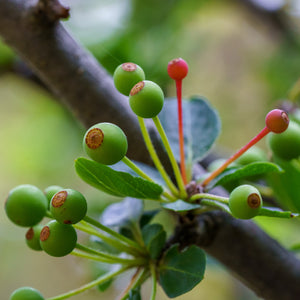
HOW TO USE
Crabapples shine in ornamental landscapes due to their seasonal appeal and compact form. They can be used alone or in groups to enhance garden structure and visual interest.
- Focal Points: Use cultivars like Malus 'Coralburst' or Malus 'Royal Gem' to anchor foundation plantings or draw attention to garden beds.
- Street Trees & Small Spaces: Narrow or upright forms like Malus 'Adirondack' or Malus 'JFS-KW5' fit well along walkways or driveways.
- Pollinator Gardens: Crabapples bloom early in spring and are a valuable nectar source for bees and butterflies.
- Bird Gardens: The colorful fruits provide a winter food source for birds, especially in cultivars like Malus 'Red Jewel' or Malus 'Golden Raindrops'.
- Mixed Borders: Pair with spring bulbs, ornamental grasses, or flowering shrubs like Hydrangea paniculata or Spiraea japonica for layered interest.
Whether used as an anchor in a front yard bed or lining a driveway, crabapples provide a dynamic focal point with flowers, fruit, and foliage that evolve throughout the seasons.
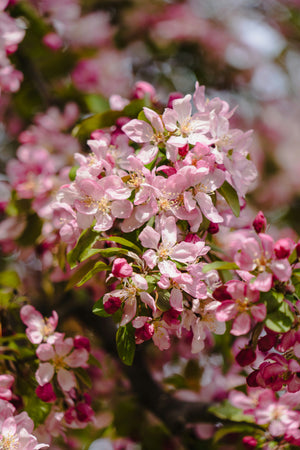
Common Questions
Are crabapples edible? While technically edible, most crabapple fruits are very tart. Some varieties are used to make jellies, cider, or vinegar.
When to prune crabapple trees? Prune in late winter or early spring before new growth begins. Light shaping can be done after flowering if necessary.
Do deer eat crabapples? Deer may browse young trees and fruit, though crabapples are not a preferred food source.
How big do crabapple trees get? Mature height depends on the variety—dwarf types may reach 8–10 feet, while standard forms grow 15–25 feet tall.
How long do crabapple trees live? With proper care, crabapples can live 30–70 years or more, depending on variety and environmental conditions.
Are crabapples bad for dogs? The seeds, like those of all apple species, contain small amounts of cyanogenic compounds. While serious poisoning is rare, it’s best to discourage pets from eating crabapple seeds in large quantities.
How fast do crabapple trees grow? Crabapples are moderate growers, typically gaining 12–24 inches per year during establishment.
When do crabapple trees bloom? Most crabapples bloom in mid- to late spring, usually from April to May, depending on the climate and variety.
Conclusion
Crabapple trees bring four seasons of beauty, from their dazzling spring blooms to colorful fall fruit and interesting winter form. With options for every landscape size and style, these adaptable ornamentals offer long-term value and ornamental impact. Whether you're looking to create a focal point, support pollinators, or enhance curb appeal, there's a crabapple cultivar ready to deliver year-round interest.
The Crabapple Collection
Sold Out
Sold Out

